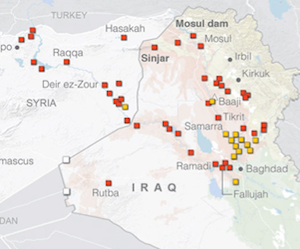WASHINGTON -- President Barack Obama's administration's best-case scenario for political transition in Syria does not foresee Bashar Assad stepping down as the country's leader before March 2017, two months after Obama leaves office, according to a document obtained by The Associated Press.
An internal timeline prepared for U.S. officials dealing with the Syria crisis sets an unspecified date in March 2017 for Assad to "relinquish" his position as president and for his "inner circle" to depart. That would be more than five years after Obama first called for Assad to leave.
The State Department said Wednesday that the timeline was prepared late last year as a guide for Secretary of State John Kerry and other U.S. diplomats working on a political transition for Syria.
Spokesman John Kirby described the document as a "staff-level think piece" that is "preliminary and pre-decisional" and not "an official position." He also said it is "not an accurate projection of plans by the international community to effect a political transition in Syria."
However, many of the milestones mentioned in the document comport with the basics of the U.N.-endorsed plan, and other officials said they were an accurate reflection of the administration's thinking. One official, who spoke on condition of anonymity to discuss the private document, said the goal for Assad to leave in March 2017 might slip even further.
According to the timeline, Syria would hold elections for a new president and parliament in August 2017 -- about 19 months from now. In the interim, Syria would be run by a transitional governing body.
The latest blueprint seeks to end Syria's five years of conflict, which has killed more than 250,000 people and allowed the Islamic State extremist group to carve out a would-be caliphate across parts of Iraq and Syria.
Among the hurdles the plan faces is the growing rift between Sunni-led Saudi Arabia and Shiite-ruled Iran, which back opposite sides in the Syria conflict.
Saudi Arabia executed a prominent Shiite cleric and then severed diplomatic relations with Iran last week after its embassy in Tehran was stormed by a mob protesting the execution.
If Saudi-Iranian tensions can be overcome, if peace talks in Vienna between the Syrian government and opposition go ahead later this month as planned and if they are successful, the biggest challenge to the U.S. timeline is still that no one else has yet agreed to its specifics, particularly those related to Assad's departure.
Assad has steadfastly refused to step down. The timeline offers no explanation for exactly how Assad would leave or what his post-presidential future might hold.
His chief backers, Russia and Iran, have resisted efforts to determine Syria's future leadership, insisting that Assad's future is a decision for the Syrian people. The U.S. timeline calls for Assad to leave six months before elections would be held.
The United States is balancing numerous considerations as it seeks to quell Syria's violence and advance several strategic objectives. Its top priority now is rooting out the Islamic State from its headquarters in northern Syria.
Obama and other U.S. officials have promised for years to end the Assad family's 45-year-grip on Syria, arguing that a leader who stands accused of using barrel bombs and poison gas on his own people has lost legitimacy.
In recent months, Washington and its allies in European capitals have retreated from demands that Assad leave power immediately as the Islamic State gained territory in the region and the priority shifted to defeating the militant group.
Start time near
The timeline document starts Syria's new political process next month. An 18-month transition period would be initiated, consistent with the plan endorsed by the U.N. Security Council last month. The U.N.'s special envoy for Syria, Staffan de Mistura, has set a Jan. 25 date for government-opposition peace talks to begin in Geneva.
The U.S. timeline envisions the Security Council signing off on a framework for negotiations between Assad's representatives and the opposition, leading to the formation of a security committee in April. That would be accompanied by an amnesty for some government and military members, and moderate opposition leaders and fighters. The transitional governing body would then be created.
In May, the Syrian parliament would dissolve, according to the timeline. The Security Council would recognize the new transitional authority and lay out the transition's next steps. These include major political reforms, the nomination of an interim legislature and an international donors' conference to fund Syria's transition and reconstruction.
The next six months, through November -- when Obama's successor is elected -- would be devoted to the sides drafting a new constitution. The Syrian people would get a chance to vote on that document in a popular referendum in January 2017, according to the timeline.
Only then would the process lead to what Washington calls the root cause of the entire conflict and the growing extremist threat across the Middle East and beyond: the end of Assad's rule of Syria.
In March 2017, the timeline reads: "Asad relinquishes presidency; inner circle departs." (The document uses the U.S. government's preferred spelling of Assad.)
Syria's new government would assume full powers from the transitional body after the parliamentary and presidential elections in August.
Syrian fighting
As the State Department considers its role in negotiating Assad's removal, fighting in Syria continues.
In central Homs province, gunmen shot and killed the commander of the Ahrar al-Sham rebel group, activists and an official from the group said.
Abu Rateb al-Homsy was killed Tuesday, said Labib al-Nahhas, a member of Ahrar al-Sham, who mourned the passing of his comrade on Twitter.
The Britain-based Syrian Observatory for Human Rights said al-Homsy was shot while in a car in the village of Farhaniyeh with his wife, who was wounded.
Several commanders of insurgent groups have been killed in recent weeks in Homs. No one has claimed responsibility for the killings.
Ahrar al-Sham is one of the most powerful Syrian rebel groups and is active in different parts of the country.
On Wednesday, several mortar rounds struck residential neighborhoods in the capital, Damascus, killing at least eight people and wounding at least two dozen others.
Syrian state media said "terrorists" from the Army of Islam rebel group fired the shells from the suburb of Eastern Ghouta, adding that the death toll was likely to rise, given the high number of critically wounded people.
The Observatory, an opposition activist group tracking violence inside the country, reported the same death toll and said about 30 were wounded, some with life-threatening injuries.
Assad's government refers to all armed rebels as terrorists. Some rebels fire indiscriminately into neighborhoods they consider to be filled with Assad supporters, while the Syrian army often bombs opposition-held neighborhoods with barrel bombs that cause many civilian casualties.
Besides fighting Assad, the Army of Islam also is battling the Islamic State. Although Washington has avoided supporting of the Army of Islam, it has praised it for backing a U.S.-Russian mediation effort with Assad, and opposing the Islamic State.
The Syrian government considers the Army of Islam, whose commander Zahran Alloush was killed in an airstrike last month, to be "terrorists" with whom it will not negotiate.
Information for this article was contributed by staff members of The Associated Press.
A Section on 01/07/2016


